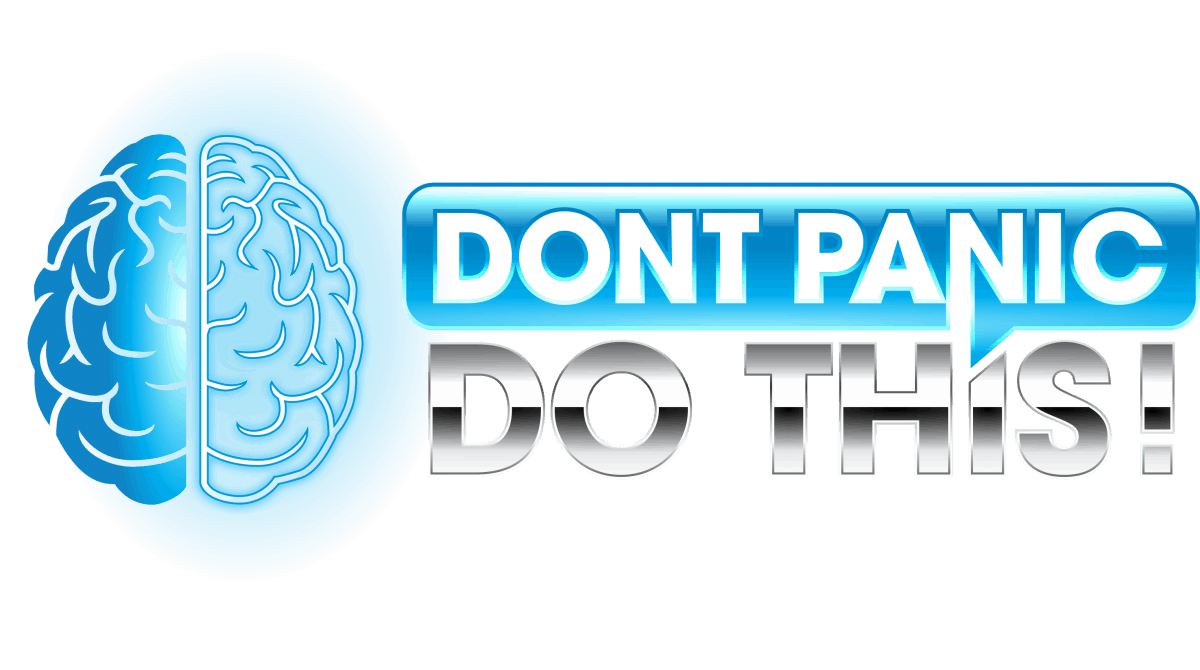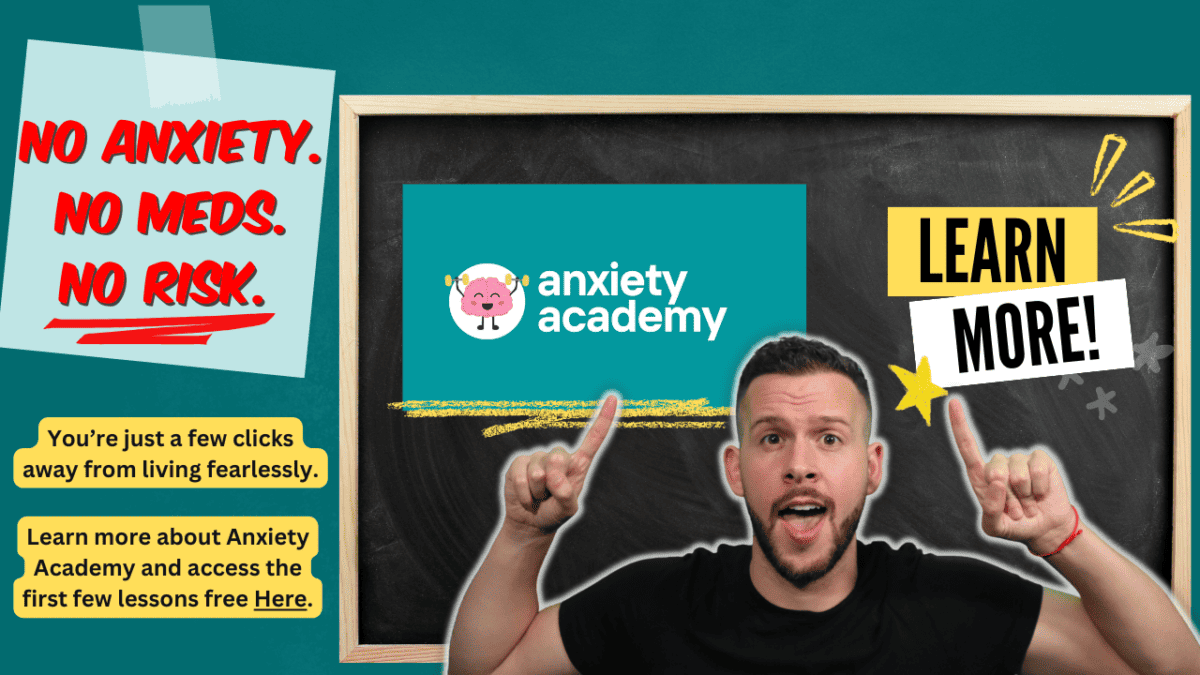Everyone has something that they’re afraid of. Most of us accept our fears as unchangeable facets of our personalities, but this doesn’t always need to be the case. Through gradual exposure therapy, or systematic desensitization, it’s possible to eliminate any fear. So, what is gradual exposure therapy?
Exposure therapy is a form of cognitive-behavioral therapy used to treat various anxiety disorders by exposing a person to their fears. Gradual exposure, also called systematic desensitization, eases a person into this process by starting with mild negative stimuli and gradually increasing the difficulty.
In plain English, gradual exposure therapy helps us to eliminate our fears and anxieties by slowly and safely taking us out of our comfort zone.
If this still sounds a bit confusing, or even a bit intimidating, no worries! Keep reading and I’ll explain everything. Gradual exposure therapy is much easier to understand and implement than it sounds!
Alright, let’s dive in!
Before We Start: The Basics of Fear and Anxiety
First off, I’d like to take the opportunity to remind you of our medical disclaimer. I’m not a doctor, and the contents of this website are not intended to substitute for professional medical advice, diagnosis, or treatment. Everything on this website is based solely on my own personal experience with panic disorder and anxiety.
With that said, I want to make sure you understand a few basic things about anxiety before we get into the nitty-gritty of exposure therapy.
The first step to conquering any fear is to understand the nature of the beast that is fear itself.
Luckily, I’ve already posted an article explaining the science of fear, and exactly what anxiety is and why we experience it. That article will give you an evolutionary background and understanding of why you have these feelings in the first place.
This may seem a bit rudimentary to some of you, but if you don’t know the basics of anxiety, you’re going to have a really hard time with this next stuff.
Seriously. Take a few minutes and read that article first if you haven’t already. You won’t regret it.
What is Exposure Therapy?
How I Learned About Exposure Therapy
No one with a fully functioning brain is immune to the fight or flight response. Any man with a will to live will feel his heart race, and palms sweat, when a gun is pointed at him. Fear is our evolutionarily programmed drive to survive. Everyone experiences anxiety to some degree in their life, and there is no shame in it.
During my early high school years, I used to be an extremely anxious kid. I’d have random panic attacks and general anxiety that I couldn’t explain or control. Nobody knew, not even my own mother, because I told nobody; I just didn’t talk about it. It'd probably have been smart for me to have seen a psychologist, but I didn't. I managed to successfully avoid facing my fears for longer than most. But ultimately, I knew that avoidance was only a short-term answer to my problems; not the long-term solution.
To really be the best we can be, we need to learn to face (and thereby eliminate) our fears. So, I began to consider the most effective way to destroy any thoughts of fear or anxiety in my brain. The solution I found most effective? Exposure Therapy.
The Two Strategies for Exposure Therapy
While there are many ways to cope with anxiety, hands down the best way to eliminate situation-specific anxiety, or phobias, is through exposure therapy. In fact, exposure therapy is massively useful when applied to just about any anxiety disorder.
There are typically two main strategies for implementing exposure therapy:
- Flooding – this is the “dive right into it” method, where a person is thrown into a highly anxiety-provoking situation (under safe conditions) in an attempt to rapidly become desensitized to their fears and unlearn their associated anxieties.
- Progressive Exposure – also known as systematic desensitization, or gradual exposure therapy. This method starts a bit slower, allowing a person to slowly take steps outside of their comfort zone over time. Starting with stimuli that only cause mild anxiety, a person is progressively introduced to more difficult situations as they unlearn their anxieties over time.
Regardless of the method you prefer, the way that exposure therapy works is by facing your fear head-on. This can be done quickly with Flooding, or slowly with progressive exposure / systematic desensitization / gradual exposure therapy.
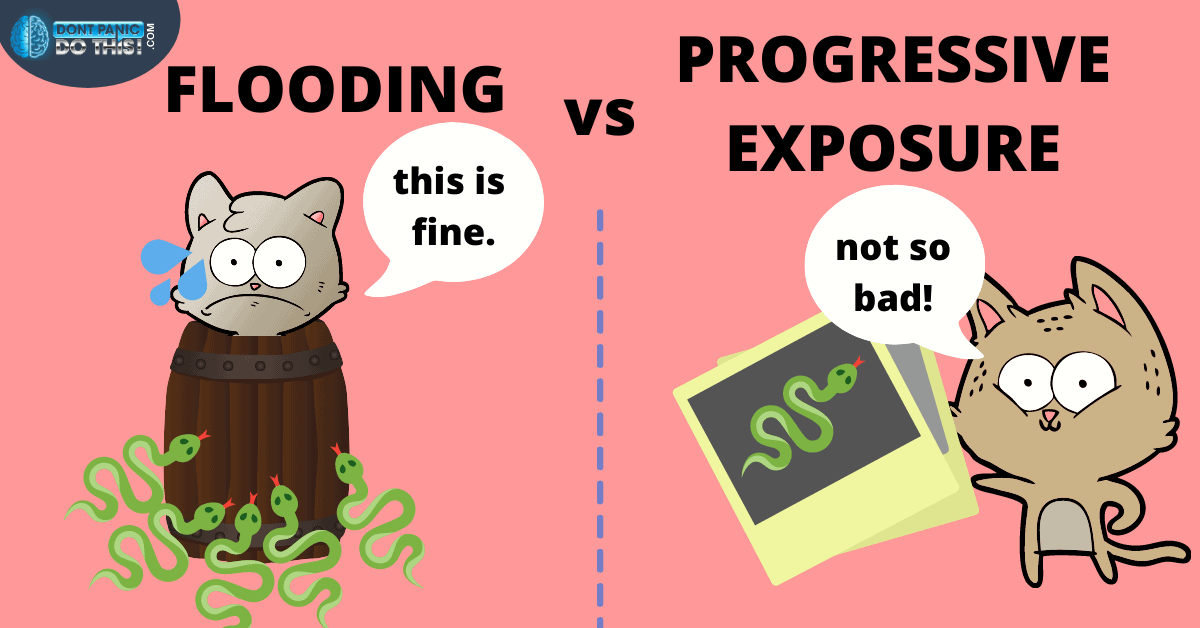
Now, trust me, I understand.
When you truly fear something, the thought alone of facing it head-on makes your stomach drop.
“How does this guy think he’s going to get me to willingly enter the one situation that stresses me out?”
For most people, the thought of engaging in exposure therapy can cause a bit of anxiety. And I totally get that. This is why, for most people, I personally believe that progressive exposure via gradual exposure therapy is the smarter way to go.
I personally wouldn’t recommend that a person who is afraid of snakes immediately take a stroll through a field of snakes (even if they’re friendly snakes!). This might work for some people, and more power to those people. But you always run the risk of things not going so well, experiencing retraumatization, and ultimately reinforcing your fear and making it even worse than before.
To mitigate these risks, I typically advocate for gradual exposure therapy rather than flooding. Perhaps in the future I will write about some strategies for flooding, but for the purpose of this article we will be only be focusing on systematic desensitization, or gradual exposure therapy.
Gradual Exposure Therapy… Like Mental Vaccinations
The human mind and body are impressively resilient.
If we wanted an individual to develop immunity to an illness, we might inject them with a small, weakened amount of that illness; a vaccine. This would provoke the individual’s immune system to adapt in such a way that it will know how to fight such an illness in the future.
You can think of exposure therapy as a vaccine for the human psyche; it’s like a series of anti-phobia shots.
We wouldn’t shoot a man with live rabies for living near a squirrel nest; and we won’t throw a man in a snake tank to cure his fear of snakes.
Instead, through gradual exposure therapy, we will gradually conquer a fear through small, but increasingly larger doses of situational exposure.
You’re going to step out of your comfort zone like entering a cold pool; one slightly unpleasant step at a time until you’re swimming.
Fear Extinction – Why Exposure Therapy Works
The human brain is comprised of over 100 billion neurons, connected by over 100 trillion synapses; and these neural pathways are constantly changing. Every day, every second, every action, every thought you have alters these connections.
This is why practicing a sport each day will make you progressively better at that sport. Your neural wiring is adapting to learn and understand the motions and responses more effectively and efficiently. Similarly, if you avoid a fear, the neural pathways for fearing that stimulus will be reinforced and strengthened.
But, when you face your fear successfully, your brain will realize that the situation/stimulus never really posed a threat to your safety. The neural pathways associated with fearing the stimulus will be weakened. This is called fear extinction, and to achieve fear extinction is what we strive for when we face our fears in small, controlled doses.
We want to unlearn the fear slowly, without slipping up and throwing ourselves deeper into the abyss.
Take baby steps in the right direction and fear extinction should occur over time.
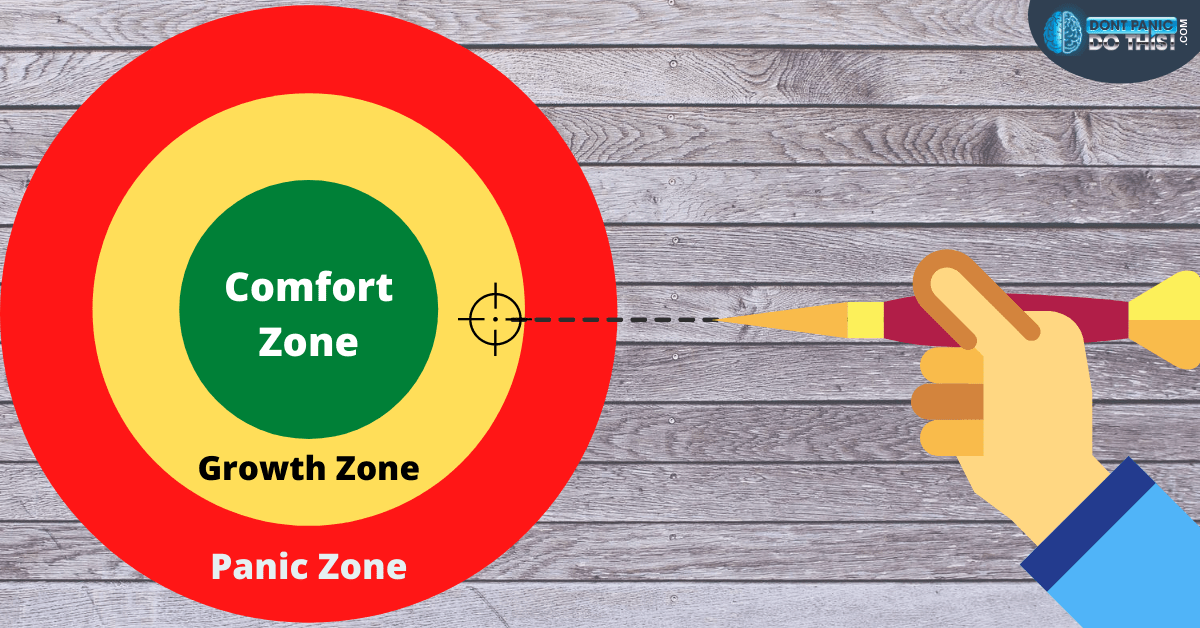



How to Use Gradual Exposure Therapy
By this point, you should have a good idea of what exposure therapy is and why it’s so effective. When it comes to unlearning a specific fear or anxiety, gradual exposure therapy is one of the most practical and effective methods that anyone could employ.
While exposure therapy is best done under the guidance of a licensed therapist or psychologist, most of the principles are pretty easy for anyone to understand.
If it’s asking a woman for her number that you fear, perhaps you could start with a “hello.”
If you’re afraid of dogs, ask yourself… “Could I pet a puppy?”
For a fear of speaking in front of the classroom, could you lead the conversation in a group of three friends? How about five?
Whatever fears have you cornered, ask yourself what kind of steps you could reasonably take outside of your comfort zone, and start there.
This is what gradual exposure therapy looks like in a clinical setting:
Gradual Exposure Therapy in 3 Simple Steps
- Establish an Exposure Hierarchy – Identify the source of anxiety by choosing a specific anxiety trigger (e.g. Snakes). Create a list of events related to that list, and rank them in order from least stressful to most stressful (e.g. from hearing the word “snake,” to holding a snake). This list will be subjective, with the event that would be most stressful to you ranked highest.
- Learn Coping Mechanisms – A therapist can teach you coping and relaxation techniques to help you deal with your anxiety response. These techniques could include deep muscle relaxation, meditation, or other strategies for putting the mind in a relaxed and non-anxious state (There are many resources for such coping strategies elsewhere on this site!).
- Connect the Stimulus to the Coping Method – Now, you would practice your preferred coping mechanisms until you felt completely calm and at ease. Then, starting with the least stressful event listed on your exposure hierarchy, you would be presented with a minimally stressful stimulus (e.g. Hearing the word “snake”). If you were able to handle this without being thrown into a state of panic and anxiety, you would move up the list and be introduced to the next stimulus (e.g. Looking at a photograph of a snake). This process would continue until you made it through the list, or until you reached a point where the presented stimulus was evoking significant anxiety. In future therapy sessions, you could attempt to break past the previous session’s “comfort zone.”
In other words, gradual exposure therapy is implemented by having you make a list of stressful events that are related to a specific anxiety or phobia of yours. You rank this list in order of which events stress you out the most, to which stress you out the least. Then, you learn relevant coping mechanisms to help you reach a state of calm relaxation at will. These coping mechanisms are used and, once in a state of calm, you are presented with progressively more stressful events in an attempt to gradually eliminate your fears.
Many people will benefit most from this if they work alongside a therapist. But, in case this is not an option for everyone, let’s discuss how a person might do this themselves from home.
1. Establish an Exposure Hierarchy
The first step to systematic desensitization is to create your exposure hierarchy. If you’re doing this by yourself, you’ll have to think critically about setting realistic and achievable goals for yourself. The least stressful event on this list should be a relatively small step outside your comfort zone; while the most stressful event on this list should be probably be your end goal, or what you hope to be able to do without anxiety by the end of the process.
To give you an idea of what this might look like, I’ve come up with a (completely hypothetical) example of an exposure hierarchy using snakes as the anxiety trigger (sorry, readers with ophidiophobia!):
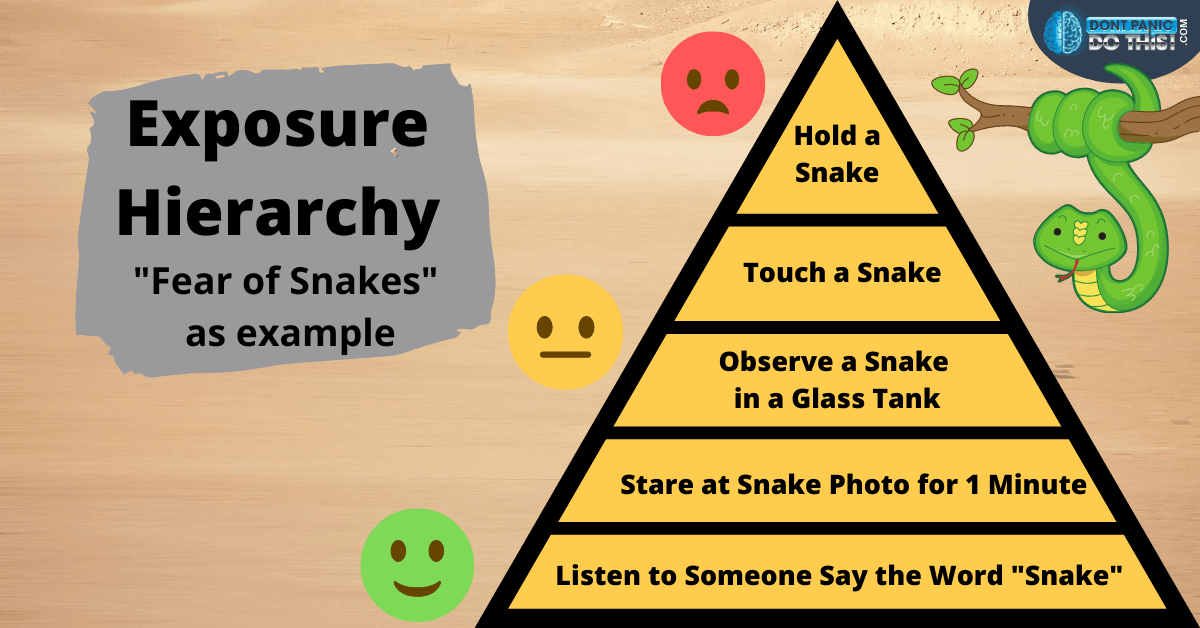



Remember, you’re just making a list. Yours doesn’t need to be in the shape of a pyramid or anything like that, but if it’s easier for you to visualize that way, go for it!
Please remember to never put yourself in a dangerous situation throughout this process. For example, holding a wild or venomous snake is not a smart way to eliminate your fear of snakes!
2. Learning Coping Mechanisms
As I’ve said before, if you’re fortunate enough to have a psychologist help you with this that’s great. If not, there are still plenty of resources on this site that can help you to understand and establish coping mechanisms for putting your mind in a state of calm relaxation.
I generally suggest that anyone looking to beat panic disorder or another anxiety disorder go through all of the steps in order on the Start Here page. If you’ve done so already, you should be familiar with these anxiety prevention methods.
Amongst these methods, I particularly recommend you read up on meditation and on how to stop a panic attack. For starters, these can serve as effective coping mechanisms to help one achieve a calm and relaxed state. Alternatively, feel free to explore the site on your own for more options.
Whatever coping mechanisms you decide to roll with, make sure you know them well and that they are effective for you. You’ll need them for the next step.
3. Connect the Stimulus to the Coping Method
When you’re feeling ready to test your limits and work towards fear extinction, use your coping mechanisms to help yourself feel calm and relaxed.
When you’re ready, you can start working your way up your exposure hierarchy, starting with the least stressful event you listed. Utilizing your practiced coping mechanisms while the stimulus is presented, try and remain as calm as possible throughout the event. If all goes well, take some time to regroup, and present the next event when you are ready for it. Continue exposing yourself to each stimulus, and see how far you can go without panicking.
You may also wish to experiment with the time frames a bit. If, for example, you panic after holding a snake for a minute, perhaps you could practice holding a snake for smaller periods of time and eventually build up to a full minute or longer over time.
It’s important to keep in mind that you are not expected to complete your whole exposure hierarchy in one sitting. Go as far as you can comfortably go, and be proud of your progress. Next time, you can challenge yourself to go even farther!
Bonus Tip: Alternative Forms of Exposure Therapy
While utilizing systematic desensitization, you may find it useful to experiment with some of the alternative forms of exposure therapy. These include:
- In Vivo Exposure Therapy – This literally just means “in person” exposure therapy. This is the standard form of exposure therapy I’ve been referring to exclusively up until now. Any time you are facing your fears physically and in-person, you are practicing in vivo exposure therapy. In vivo exposure therapy is generally considered the most effective form of exposure therapy.
- Imaginal Exposure – This involves actively imagining a situation that evokes feelings of stress or anxiety. Imaginal exposure may not seem as effective as in vivo exposure, but it can still be useful in cases of severe anxiety or when a specific event (feared thoughts and memories) cannot be safely or effectively recreated in person.
- Interoceptive Exposure – Interoceptive exposure can be effective for specific phobias, or for panic disorder or PTSD, since it focuses more on physiological symptoms. This can involve confronting the very physiological symptoms you’re afraid of, in an attempt familiarize yourself with them and decrease your fear of them over time.
- Virtual Reality Exposure Therapy (VRE) – Virtual reality exposure therapy falls somewhere in between in vivo exposure therapy and imaginal exposure therapy. As its name implies, virtual reality exposure therapy has people confront their fears in a virtual reality setting. While research around virtual reality exposure therapy is still limited at this time, it could prove to be quite effective since it combines the realistic setting of in vivo therapy with the limitless possibilities of imaginal exposure.
For most people, in vivo exposure will likely suffice and prove to be the most effective method. However, it could be useful to find ways to incorporate the other forms of exposure therapy if you are feeling creative.
Exposure Therapy for Panic Disorder
For many phobias and anxiety disorders, it can be fairly obvious how to go about exposure therapy. As long as you can identify your anxiety trigger, you know exactly what kind of events to model your exposure hierarchy after. But I’d like to take a moment to show some love for panic disorder; it can seem a bit trickier to implement systematic desensitization for those with panic disorder, so let’s take a closer look at how this might be done. If you don’t have panic disorder, or if this just doesn’t apply to you, feel free to skip forward to the next section!
The first thing you need to ask yourself when trying exposure therapy for panic disorder is: what, if anything, causes you to have panic attacks?
This might be difficult for some of you, as panic attacks can often seem random, and you may not have any obvious panic attack triggers. But try and give it some thought. Think about situations like:
- Attending social events
- Speaking in public
- Leaving the house
- Going for a drive
- Taking an exam
- Flying in an airplane
Do any of these situations cause you to feel particularly anxious or panicky? If so, we’ve found an area to work on, and you can address these specific triggers through gradual exposure therapy the same way that someone with a phobia might.
On top of any specific triggers that might be causing your panic attacks, you’ll also want to implement exposure therapy for panic disorder as a whole. If you’ve already read our full article on panic disorder (if you haven’t yet, you definitely want to do that before going forward!), you know that panic disorder is essentially just the “fear of fear itself.” So, just like any other phobia, we want to address panic disorder by learning how not to be afraid of our panic attacks.
*I truly can’t emphasize enough that this should be the last step you take in your journey toward beating panic attacks. What I mean by this is that you should have completed the rest of this checklist in its entirety before taking on the next step.
Got it?
Okay.
I’m going to trust that you did all the other stuff first, otherwise this next step could be difficult!
Challenging Your Panic Attacks Head-on
The final step that I personally suggest for helping you to beat panic disorder is to utilize exposure therapy and challenge your panic attacks head-on.
Having completed all other steps, you should now be feeling informed, relaxed, equipped, and prepared to deal with your panic disorder. You should already be significantly less fearful of your panic attacks, which puts you in a position of strength for this final step.
Like all other forms of exposure therapy, I encourage you to utilize your favorite coping mechanisms to fully relax. Once relaxed and ready, you should challenge your panic attacks to occur. At this point, one of two things will happen:
Being able to fearlessly challenge panic disorder, and not having a panic attack as a result is a pretty solid indication that you’re doing incredibly. This challenge represents the top of the exposure hierarchy for people with panic disorder. Once you’ve learned how not to fear your panic attacks, there’s not much left of your panic disorder to contend with.
And, like I said before, even if you do have a panic attack, it’s absolutely not a loss. If you have the courage to challenge a panic attack to occur, it’s a win you should be proud of no matter what happens! Just like a person working up the courage to touch a snake – even if they have a panic attack after touching the snake, it’s still such a huge improvement from the time they were afraid to approach it!
Regardless of the outcome, give yourself a huge pat on the back and be proud of yourself. Keep up the good work, and in time your panic attacks will be a thing of the past!
Combining Anxiety Supplements with Exposure Therapy
As you slowly begin to start beating back your anxiety, don’t feel the need to face your fears entirely on your own. In my personal opinion, I believe that anxiety supplements can be an effective way to help people tackle the more difficult events on their exposure hierarchy.
As I’ve said many times before, I do believe that overuse or dependence on anxiety supplements is a huge misstep in beating anxiety. However, when used occasionally and strategically in conjunction with exposure therapy, I believe it could give many people a significant advantage with lasting benefits.
The effect that conquering a fear through exposure therapy has on your neural pathways should not be lessened just because you utilized an anxiety supplement to help you get there. If an anxiety supplement could mean the difference between taking that next step outside of your comfort zone vs. not taking it, I vote taking for taking the supplement.
For figuring out which supplement might be appropriate for various situations, feel free to check out this article on my recommended anxiety supplements. Just remember to be conservative and strategic in your use of these supplements, as to avoid developing any sort of dependence over time.
How to Keep Calm During Exposure Therapy
Facing your fears is tough, but extremely admirable.
From time to time, your fears and anxieties may get the best of you. When this happens, and you're feeling particularly panicky or anxious, it's helpful to have some coping mechanisms at your disposal!
If you haven't already, consider reading my book, Don't Panic, Do This! 100+ Ways to Stop Panic Attacks and Anxiety to learn exactly how to regain the upper hand when fear, doubt, and anxiety starts creeping in!
